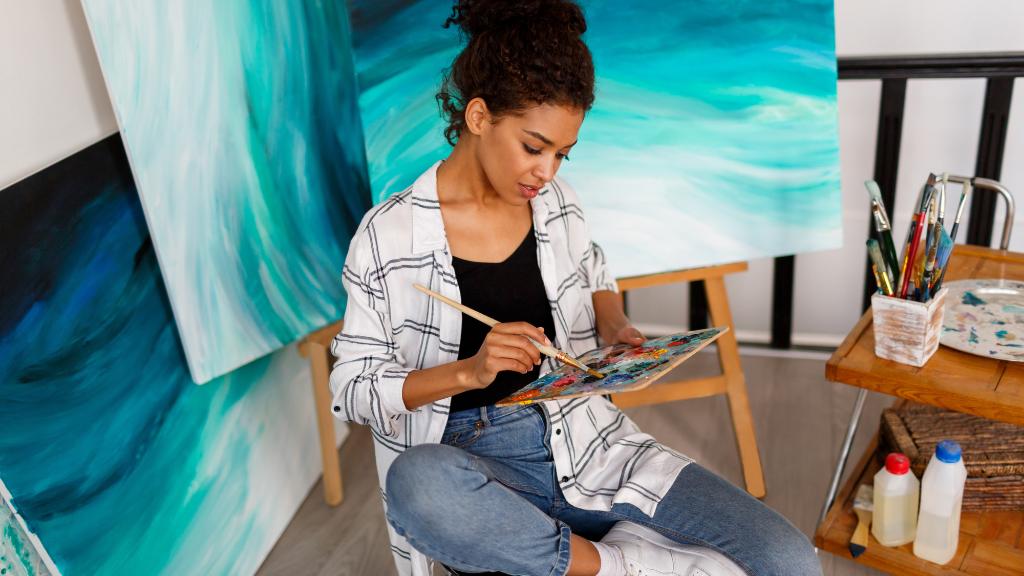canvas painting spaceis one of the most resilient fabrics out there, crafted from various materials including cotton, linen, and hemp. Its wide range of uses has made it a popular choice for a variety of tasks, ranging from upholstery to outdoor covers.
Works of art have been created on canvases for centuries, with some of the earliest surviving oils on canvases dating back to the early 14th Century. For example, a French Madonna with Angels from around 1330 exists and bears witness to the timelessness of this medium.
The use of oil paints has been prevalent for centuries, with the earliest known examples appearing during the Italian Renaissance. Painters from Venice capitalized on its affordability and availability, eager to utilize this new type of paint in their artwork.
Canvas Made of What Material?
These days, cotton is the material of choice when it comes to industrial canvases. This is due to its affordability and practicality; not only is it easier to stretch onto a frame than other fabrics, but it also has a much lower risk of breaking or becoming damaged.
When it comes to creating a strong and reliable canvas, many manufacturers and artists turn to plain weave cotton. This type of weaving technique allows for an adjustable level of tightness, ultimately providing them with complete control over their desired final product.
Types of canvas frames
Canvas panels
Beginning
painters may be overwhelmed by the range of canvas options, but there is an
economical solution. Canvas panels are a great way to start out without
breaking the bank. They offer a high quality alternative to stretched canvas,
and are more affordable than other options.
Beginning a
journey into the artistic realm can be intimidating, but with canvas panels,
you're sure to get off on the right foot. Crafted from primed cotton canvas and
attached to a rigid board, these durable materials form an ideal surface for
painting and illustration purposes.
Stretched Canvas
Creating a canvas from scratch
can be an arduous process for some artists who don't have the necessary tools
to do it. This is why pre-made, ready-stretch canvas is the perfect solution
for these creatives.
When you buy a stretched canvas, you already
have the work nearly done for you. The canvas is pulled taut over a stretcher
and firmly stapled to its thin wooden frame. All that remains is for the artist
to begin painting or drawing their masterpiece.
When it comes to protecting your artwork from
harm, stretching canvas is one of the best measures you can take. This method
of mounting the canvas utilizes cutting-edge technology to ensure that it
remains secure and intact for years.
Canvas pads
For the artist on-the-go, a handy accessory to
take along is a blank book filled with sheets of primed canvases. Canvas pads
provide the perfect surface for sketching and painting, allowing creative
expression without the need for additional materials or setup.
Great for anyone who loves to create outside of
their home, the sheets found in many sketchpads offer a great deal of versatility.
Whether you're stuck in a coffee shop or enjoying a day outside, these portable
art supplies can be taken with you and used wherever inspiration strikes.
Canvas rolls
Are you an artist who wants to make a big statement? Canvas rolls are the perfect way to create large works of art. Made from either linen or cotton, they offer plenty of flexibility when it comes to choosing the size and proportions that suit your project.
Acrylic paint set with canvas
Acrylic Paint: Working with Acrylic paint is a breeze and it's one of the most convenient painting mediums you can use. It doesn't take long for the paint to dry, and all that is required is a prepared canvas and your choice of brush or palette knife.
When you’re working with acrylics, it's important to understand the consistency of the paint that you're using. For projects that require an opaque layer, a thin acrylic will necessitate significantly more paint than other mediums.
Oil Paints: Oil paints have a distinctive quality that separates it from other painting mediums - their thick, viscous texture. This means that an artist needs to use a surface which can bear its weight and adhering to its composition.
When you choose, there is a plethora of options available. Two popular choices are traditional oil paints and the water-soluble variety. Both will provide stellar results when used correctly; however, the two types have their distinct differences that should be taken into consideration.
Gouache: When working with gouache on canvas, it is important to keep in mind that a thicker layer of paint will be necessary. Adding too much water can create unwanted effects, so ensuring that there is an appropriate balance between the two will help you achieve the desired results.
Gouache painting on canvas can be a challenging task, which is why it is usually recommended for those tackling smaller-scale projects. To avoid any difficulties with this type of painting, the scale of the project should be considered when making decisions.
how to paint on canvas
When it comes to painting, the media can play a huge role in the drying process. There are two major types of paint used today - acrylic and oil. While each offers its own unique benefits and drawbacks, one of the main distinctions between them is how they dry.
When deciding the best environment for painting, it is important to note that oil paints require warm and dry conditions, whereas acrylic paints thrive in a well ventilated area. This distinction can be crucial when it comes to creating artwork with the two mediums.
get started with your modern art oil painting on canvas, Sandhai has Everything you want. Shop online now.




Share this via
Or copy link